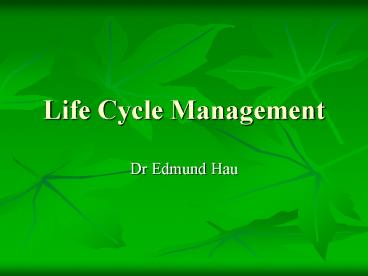Life Cycle Management - PowerPoint PPT Presentation
Title: Life Cycle Management
1
Life Cycle Management
- Dr Edmund Hau
2
Questions
- What is an Environmentally Friendly product?
- What is a Green process
- What is Sustainable Development?
3
Possible Answers
- Recycled paper?
- Energy-saving appliances?
- A landfill for solid waste?
- Plastic packaging vs paper packaging?
4
Further Questions
- How far do we look?
- Raw material extraction
- Manufacturing
- Use
- Disposal (end of life)
- Energy consumption?
- Material consumption?
- Emission?
5
(No Transcript)
6
Life Cycle Management (LCM)Life Cycle Assessment
(LCA)
- Life Cycle Management is an integrated concept
for managing the total life cycle of goods and
services towards more sustainable production and
consumption - Life Cycle Assessment is a tool for the
systematic evaluation of the environmental
aspects of a product or service system through
all stages of its life cycle
7
Brief History of LCA
- 1963 World Energy Conference.
- 1969 Coca-Cola performed a study to compare
beverage containers - Early 70s standard protocols being developed
Resource and Environmental Profile Analysis
(REPA) - 1975-early 80s slow development because of
fading threat of oil crisis, Liquid Food
Container Directive in 1985 by EC - 1988 solid waste became global issue, re-surge
of LCA - 1991 concern over inappropriate use of LCA for
marketing, lead to development of ISO14040 as a
standard approach - 2002 United Nations Environment Programme (UNEP)
and Society of Environmental Toxicology and
Chemistry (SETAC) launched the Life Cycle
Initiative
8
The Phases of Life Cycle Assessment
9
Goal and Scope Definition
- Define and describe the product, process or
activity. Establish the context in which the
assessment is to be made and identify the
boundaries and environmental effects to be
reviewed for the assessment. - Functional unit
- Defining system boundary
10
(No Transcript)
11
Inventory Analysis
- Identify and quantify energy, water and materials
usage and environmental releases (e.g., air
emissions, solid waste disposal, waste water
discharges).
12
(No Transcript)
13
Sources of data
- ? Meter readings from equipment
- ? Equipment operating logs/journals
- ? Industry data reports, databases, or
consultants - ? Laboratory test results
- ? Government documents, reports, databases,
- ? Other publicly available databases or
clearinghouses - ? Journals, papers, books, and patents
- ? Reference books
- ? Trade associations
- ? Related/previous life cycle inventory studies
- ? Equipment and process specifications
- ? Best engineering judgment.
14
Impact Assessment
- Assess the potential human and ecological effects
of energy, water, and material usage and the
environmental releases identified in the
inventory analysis. - Impact categories
- Characterisation
- weighting
15
(No Transcript)
16
Characterization of Global Warming Impacts The
following calculations demonstrate how
characterization factors can be used to estimate
the global warming potential (GWP) of defined
quantities of greenhouse gases Chloroform GWP
Factor Value 9, Quantity 20 kg Methane GWP
Factor Value 21, Quantity 10 kg Chloroform
GWP Impact 20 kg x 9 180 kg CO2
equivalents Methane GWP Impact 10 kg x 21
210 kg CO2 equivalents Intergovernmental Panel
on Climate Change (IPCC) Model
17
Examples of LCI and LCA Software
- Ecoinvent by Swiss Centre for Life Cycle
Inventories - GaBi by PE Europe GmbH and IKP University of
Stuttgart - SimaPro by PRé Consultants
- US LCI Data National Renewable Energy Lab
18
Interpretation
- Evaluate the results of the inventory analysis
and impact assessment to select the preferred
product, process or service with a clear
understanding of the uncertainty and the
assumptions used to generate the results.
19
An exampleLCA of Cardboard Box
20
(No Transcript)
21
(No Transcript)
22
(No Transcript)
23
(No Transcript)
24
(No Transcript)
25
(No Transcript)
26
(No Transcript)
27
(No Transcript)
28
(No Transcript)
29
(No Transcript)
30
(No Transcript)
31
(No Transcript)
32
LCA of Airbus A380
33
The A380 has been designed in order to optimise
environmental performance at each stage of the
aircraft life cycle. In particular, the high
passenger capacity with a 2-deck design and the
use of new light weight materials has decreased
the energy consumption per passenger
dramatically. The A380 is expected to use less
than 3 litres of fuel per 100 passengers
kilometres.
34
Benefits of LCA
- Quantifies and pinpoints environmental impact for
improvement - Identifies the transfer of environmental impacts
from one media to another and/or from one life
cycle stage to another - Helps decide on product/activity with least
overall environmental impact - Combines with cost and social factors to evaluate
sustainability - Eco-marketing
35
Ecolabels
36
Improvement and Management
- Modify unit process with high impacts
- Modify product design
- Mitigation measures
- Compensation e.g. carbon offset
37
Limitations of LCA
- Resource demanding
- Availability, accuracy and applicability of data
- Does not imply sustainability
- No easy communication to the public (e.g. a
single indicator, eco-labels) - It is better to be roughly right than to be
exactly wrong
38
(No Transcript)
39
Thank You































